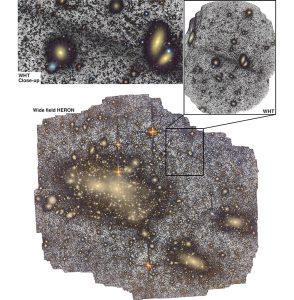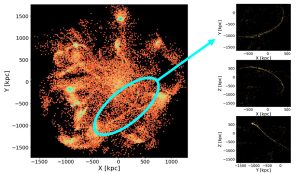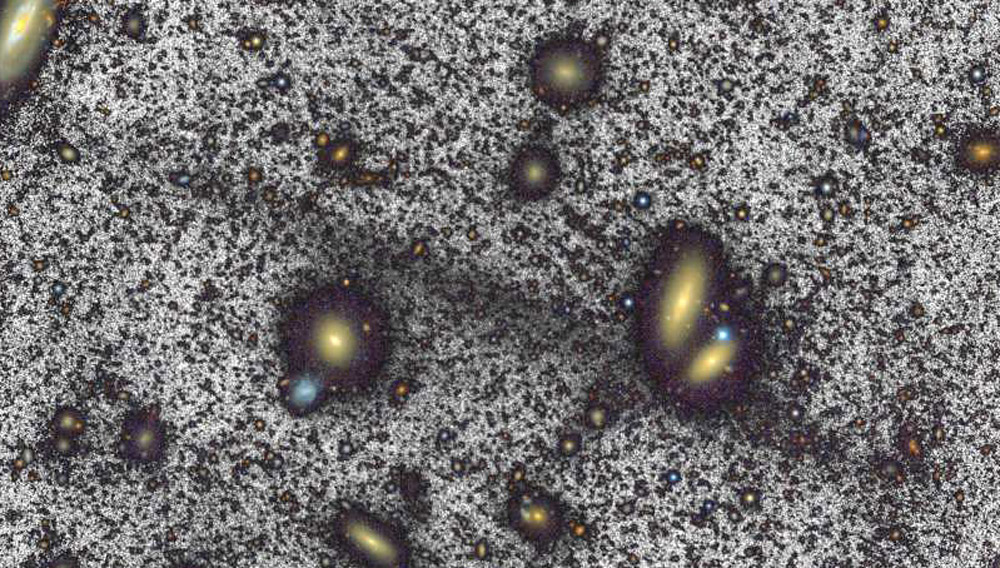An unprecedented phenomenon: Astronomers have discovered a stream of intergalactic stars in the enigmatic Coma galaxy cluster. Because this group of stars is much longer than any previously known stellar stream, it is ten times longer than the entire Milky Way. Also mysterious: the “Giant Coma Stream” is relatively narrow and located in free space far from all galaxies. How this happened and why it was not dispersed long ago remains a mystery.
Star streams are nothing unusual in the universe: in the Milky Way, many such clusters of stars and gas drifting in one direction show that our parent galaxy once absorbed smaller neighbors. Interactions between galaxies can also give rise to long streams of stars, one of which, for example, connects our Milky Way Galaxy to the Magellanic Clouds.

CC by 4.0
A thin group of stars
But now astronomers have discovered a stream of stars never seen before. The team, led by Javier Roman from the University of Groningen, wanted to study the distribution of matter and the structure of the Coma Cluster, a galaxy group consisting of more than 1,000 individual galaxies about 300 million light-years away. “The Coma Cluster is an ideal place to study galactic cannibalism, accretion and other interactions in such galaxy clusters,” the astronomers explain.
When astronomers examined the outer region of the Coma cluster more closely, they discovered something unusual: The images showed a long, thin band of stars moving together — a stream of stars. This star bar floats strangely in space, and does not appear to be connected to any of the cluster’s galaxies. “This stream of stars does not overlap with any of the visible structures in this region, and there is no galaxy that could be the origin of this stream,” Roman and his team say.
The largest stream of stars ever documented
But what’s even more surprising is that the star stream, called the Giant Coma Stream, is about 1.6 million light-years long, about ten times the length of the Milky Way. Its thin, compact structure is reminiscent of the cold streams of stars in the Milky Way, but the size of this group of stars exceeds all documented “giant streams,” Roman and his team said. To our knowledge, a stellar stream of this size has never been discovered before.
How such a long, thin strip of stars could be preserved in the turbulent environment of the Coma galaxy cluster remains a mystery to astronomers. Such streams of stars typically arise when a dwarf galaxy is pulled into such a cluster and torn apart. Normally, such long, thin bands do not remain intact for long because they are twisted and torn by gravity soon after they form.

CC by 4.0
The origin is ambiguous
But this does not seem to be the case with the giant coma stream: although it is long, it is clearly defined and relatively intact. To find out how this was possible, astronomers tried to track the formation of the star stream in the Illustris-TNG50 simulation. This allows galaxies and large cosmic structures to be reconstructed virtually and with high resolution. To do this, they allowed several large progenitor galaxies to collapse to form a virtual zombie cluster.
It turns out that in almost all runs, the resulting stellar stream was either thicker than the giant coma stream or did not last long enough. Only under very special conditions and previous masses have astronomers been able to create a single example of such a stream of stars. “This stream is similarly narrow and long as the giant Coma Stream,” they say. It also shows a similar curvature and orientation to Coma’s star band.
Is it an isolated case or a common phenomenon?
“Our simulation gives us a first idea of how such long, narrow streams of stars arise,” Roman and his team wrote. “This also indicates that they are possible in principle under common cosmological scenarios.” Whether such extended stellar streams occur frequently in the cosmic “nowhere” without a connection to a galaxy or whether the giant coma stream represents a rare exception remains to be seen. An open question for now.
But astronomers hope that future telescopes, such as the Extremely Large Telescope (ELT) currently under construction and the Rubin Observatory in Chile, will be able to learn more about the structure of this mysterious stream of stars and perhaps discover other similar specimens. (Astronomy and Astrophysics, 2023; doi: 10.1051/0004-6361/202346780)
Source: Netherlands Research School of Astronomy (NOVA)
December 8, 2023 – Nadia Podbrigar

“Social media evangelist. Baconaholic. Devoted reader. Twitter scholar. Avid coffee trailblazer.”








More Stories
Longest jets in the universe discovered – giant particle streams as long as 140 Milky Way galaxies in a row
New method reveals 307 supernova remnants
Snapchat is upping the ante on augmented reality glasses